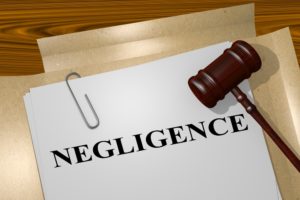When discussing an injury claim, you may often find yourself discussing the subject of negligence. Your lawyer may want to know what act of negligence was committed by the other party that led to your accident or your injuries. However, many people wonder just what negligence is, why they need to know about it, and how it can impact their claim.
Here at Jacoby & Meyers, LLP, our personal injury attorneys deal with all sorts of injury cases ranging from automobile crashes, to slip and falls, to medical malpractice suits. Yet, regardless of how different each personal injury accident is, one common concept ties these incidents together, and that is the legal theory of negligence. In today’s blog, we will delve into what negligence is, what you need to show to prove negligence, and how you can collect damages from a negligent party.
Negligence: The Legal Definition
Legally, negligence includes failing to behave with the same level of care generally expected by a reasonable person under the circumstances. Negligence can include both actions, such as driving while distracted, and omissions, such as failure to use or provide adequate safety equipment.
Establishing Negligence in an Injury Claim
To establish negligence in an injury claim, a lawyer lays out several key points to demonstrate that the liable party committed an act that caused or contributed to the claimant’s injuries.
Duty of Care
Establishing negligence often starts with showing that the liable party bore a duty of care to the injured party. A “duty of care” includes situations where the liable party should have taken steps to prevent the other party from suffering injuries.
Employers bear a high duty of care to their employees. Doctors bear a duty of care to their patients and must commit to providing a high standard of care that will not result in patient injury. In the case of a car accident, drivers automatically bear a duty of care to all who share the road with them and must act reasonably to prevent injury.
Breach of the Duty of Care
To clearly show negligence in an injury claim, a lawyer will next work to show that the liable party somehow breached their duty of care. A breach of the duty of care means that the liable party failed, in some way, to follow the rules and regulations that help prevent causing injuries.
For example, a driver who chooses to ignore the rules of the road, including speeding or ignoring traffic signals, breaches the duty of care to others on the road. That driver may cause circumstances under which the risk of an accident substantially increases because the driver fails to take adequate care to protect others around them. Likewise, a doctor who fails to treat a patient properly, despite clear evidence of symptoms, might breach their duty of care owed to that patient.
Causation
In an injury claim, to establish liability based on the negligence of another party, the injured party needs to clearly show that the other party’s actions, or omissions, led to an incident.
For example, every driver or pedestrian who encounters a texting driver on the road does not automatically have the right to file an injury claim against that driver. While that driver’s negligence can cause severe complications for everyone around them, if other drivers successfully avoid that driver, eliminating the risk of a collision and the property damage and injury potential associated with it, others may not have the right to an injury claim.
On the other hand, if the texting driver causes an accident, the injured party can easily show causation related to the driver’s decision to text and drive and will likely have grounds for an injury claim.
Damages
Finally, to show that the injured party has the right to file a claim based on negligence, the injured party must exhibit damages related to the liable party’s negligent actions.
Damages can vary depending on what negligent act or omissions caused the accident and the resulting injuries or losses.
Damages commonly include:
- Medical costs. Medical bills can rise incredibly high after a serious accident, leaving many people in a desperate financial situation. By establishing that you have high medical bills related to an injury, you can show that the liable party owes you compensation.
- Wage losses. Often, wage losses associated with a serious accident can prove catastrophically high and even cause immense financial difficulty for the injured party.
- Property damage. Frequently, negligent behavior results in significant property damage. For example, vehicles often suffer substantial damage in a car accident. Other accidents and incidents can result in additional property damage, including damage to the injured party’s phone and other electronics, damage to the injured party’s home, and more.
- Pain and suffering. In some cases, you may have the right to file a claim against the negligent party for non-tangible damage. This damage includes suffering such as physical pain and emotional anguish. In some cases, injured parties can successfully claim compensation for PTSD, anxiety, or depression related to a damaging incident.
If you suffer no damages due to an incident, even though it may have caused significant risk, you may not be able to show that you deserve compensation for the injuries you sustained.
Why Does Negligence Matter?

When it comes time to establish your right to compensation through an injury claim, negligence matters greatly. Accidents can happen even to the most cautious individuals. Suppose, for example, you slip and fall on a perfectly dry, clear floor with no damage or problems. While you might have severe injuries, you may have difficulty showing that someone else committed negligence causing your accident and that they bear liability for it.
On the other hand, establishing negligence in an accident can offer several advantages.
1. Showing that another party’s negligence contributed to your accident can help you as you file an injury claim.
If you cannot show that another party committed an act of negligence against you, you may not have grounds for an injury claim. Negligence stands as one of the key elements of most injury claims. You must clearly show negligence to show that you deserve compensation for your injuries.
When you talk to a lawyer about your injury claim, they will want to know how the other party caused or contributed to your accident. Simply showing that you suffered an injury may not be enough evidence to file your claim. On the other hand, if you show that the other party’s negligent actions caused your accident, you can likely file your claim.
2. Establishing negligence can help determine how much fault the liable party bears.
Sometimes, the liable party will try to argue that you caused part of the accident. In fact, in some cases, the liable party may have evidence that you contributed to the accident in some way, which could prevent you from recovering the full compensation you might otherwise receive for your injuries. Showing that the other party clearly contributed an act of negligence and that the other party’s negligence caused the majority of your accident, however, can go a long way toward helping you get reasonable compensation for your injuries.
3. Looking at the negligence that contributed to your accident may help you identify more than one party who bears liability for your injuries.
In some cases, multiple acts of negligence can contribute to the same incident. Suppose, for example, that you suffer injuries in a construction site accident. The first look at the accident lets you know that the safety equipment used to protect against that accident failed, which means the equipment manufacturer may bear liability for your injuries. On closer examination, you may further discover that the construction company failed to offer backup safety equipment that could have helped protect you against that type of accident. As a result, the construction company may also share liability for your losses.
Identifying multiple parties that share liability for an accident can make it easier for victims to get the full compensation they deserve. When multiple parties contribute to an accident, the injured party can pursue compensation from all who contributed to the incident. Ultimately, the injured party might recover substantially more compensation for their injuries than if they only pursued compensation from the primary party that caused the accident.
How Can You Establish Negligence for an Injury Claim?
To establish negligence for an injury claim, you must show that the liable party did not act with the care or caution that someone else, under the same circumstances, would have shown. It can, in many cases, prove very difficult to establish negligence, especially in cases where the liable party might not admit to any responsibility for the incident.
A lawyer can offer significant support as you progress with your injury claim, including finding evidence that can establish the other party’s negligence.
- Talking to witnesses. Often, witnesses can offer a great deal of perspective about what likely led to an accident. Witnesses often have a more accurate picture of what took place than those involved in the accident, making it easier to lay out what happened.
- Reviewing any video footage of the accident. Video footage of an accident can go a long way toward helping establish negligence. Many stores, for example, have security cameras that can make it easier to see how a slip and fall occurred. Drivers involved in an accident may want to review dash camera footage or check local security or traffic camera footage with their lawyers to gather evidence to establish what led to the accident.
- Looking at the scene of the accident. Even in cases where the liable party may quickly clean up the accident scene after an incident, a look at the scene can offer a number of insights. Inspecting an accident scene may, for example, reveal worn flooring, clutter, or damage that likely led to the accident. This information can make it easier to show what exactly caused the accident.
- Talking to industry experts. In many cases, to establish negligence, you may need to bring in an expert witness who can explain what likely led to the accident and what actions the liable party should have taken instead. A doctor might, for example, lay out the course of treatment that a care provider should have taken based on the symptoms presented by the patient. In the case of a car accident, an expert might look over the damage to the vehicles to determine what likely caused the accident or whether a party acted negligently. Often, an expert witness’s testimony will help show what led to the accident, making it easier to establish liability in front of a jury or the insurance company, if needed.
- Reviewing medical records. To establish damages related to an injury, you may need to provide your medical records, which is evidence of the specific damages you sustained as a direct result of the negligent party’s actions. Medical records can also help establish the cost of treating your injuries, which will support your claim for damages.
Contact a Lawyer for Help Establishing Negligence After an Accident
If you suffered serious injuries due to another party’s negligent actions, seek legal help to establish the other party’s negligence and pursue the compensation you deserve.
Contact a personal injury lawyer near you to discuss how you can best establish negligence for your accident and what compensation you can pursue for your injuries.
